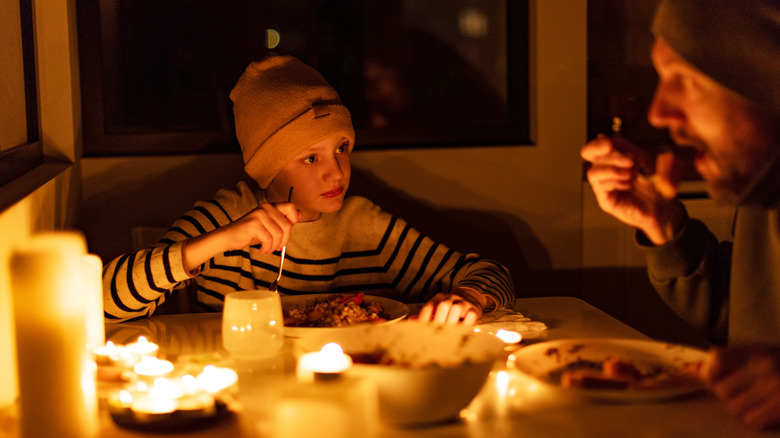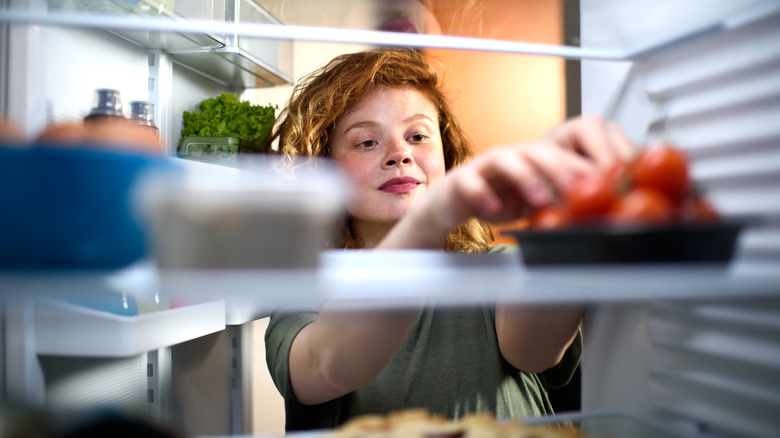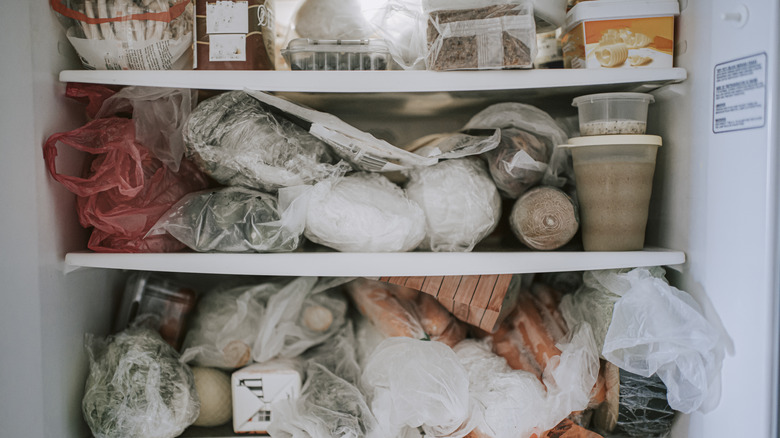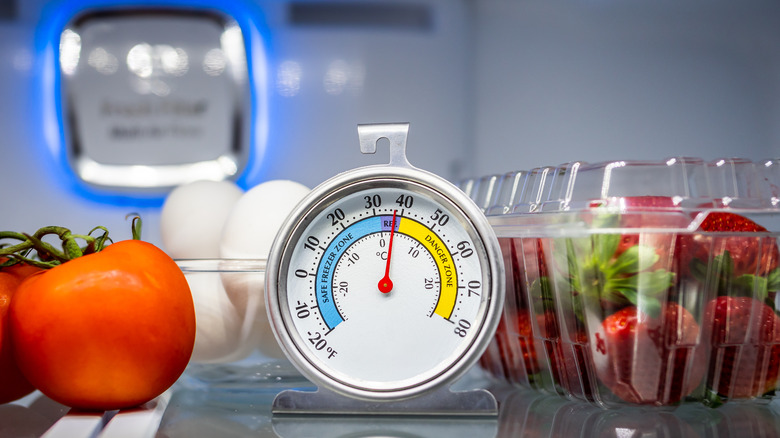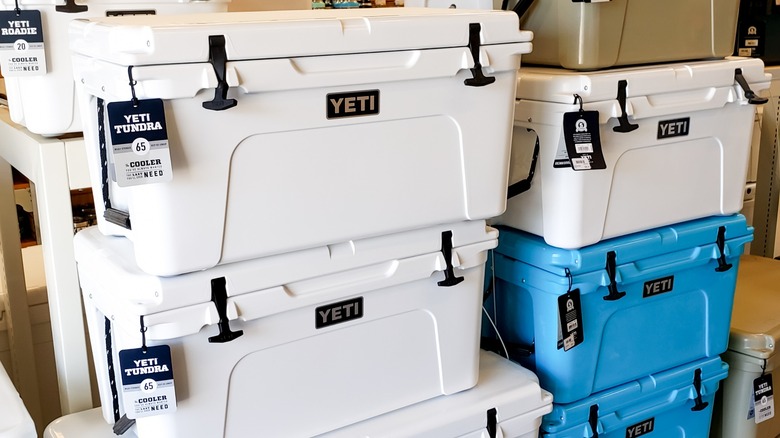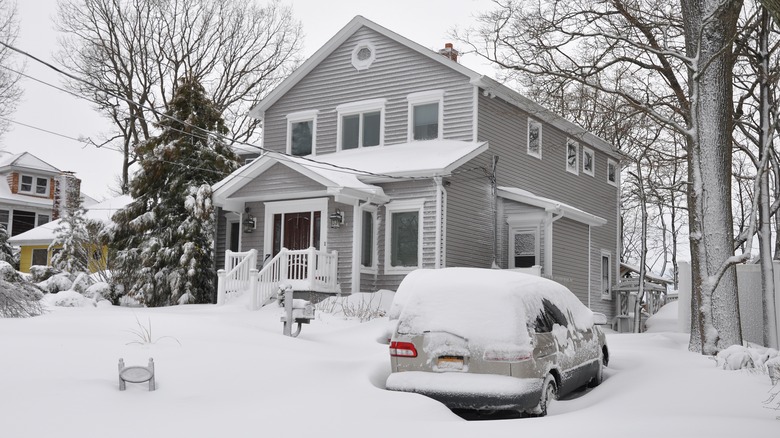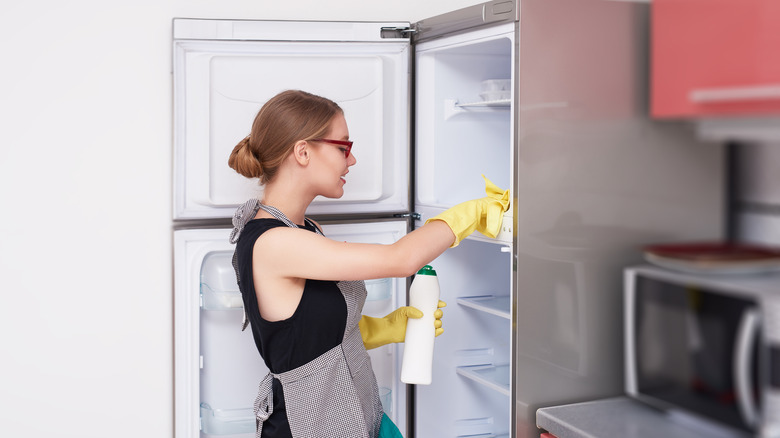The Ultimate Guide To Food Safety During A Power Outage
Thunderstorms, hurricanes, and other extreme weather events can cause power outages. Beyond the frustrations of being without light, heat, or air conditioning, you also have to worry about the food you have stored in your refrigerator or freezer. Many of the foods we store in our fridge or freezer are perishable. They not only taste better when cold, but they also require these colder storage temperatures to make sure they remain safe to eat.
But just how warm is too warm? Are there hard and fast rules regarding what you should do with refrigerated and frozen food in the event of a power outage, or how long they'll remain safe to eat? What about things you could do to help prevent foods from spoiling the next time you lose your power? The next few sections will address all of these questions — and more — to help you minimize food waste, while also protecting yourself and others in your home from foodborne illnesses.
Refrigerators can keep food safe for a few hours
In the event of a power outage, food can last in a fridge for up to four hours, according to the Centers for Disease Control and Prevention. To help prevent foods from spoiling faster than this, avoid opening the doors to the refrigerator as much as possible. Each time you open the doors, you'll let some of the cold air out. If this happens too much, the food won't last as long — meaning it may end up in the trash or compost bin once the power is restored.
With the doors closed, however, the temperature inside the fridge should stay cold enough to keep foods at or below 40 degrees Fahrenheit — since most fridges are around 40 degrees internally, when the power is on. When the temperature of food items is between 40 and 140 degrees Fahrenheit, it enters what is called the Danger Zone. As the United States Department of Agriculture explains, bacteria can multiply much more rapidly in this temperature range — possibly even doubling every 20 minutes. If the power is out for more than four hours, refrigerated foods are more likely to enter the Danger Zone.
A full freezer can keep food fresh for up to 48 hours
While foods may only last for up to four hours in the refrigerator, they will remain frozen for longer than that. However, the exact length of time they'll remain frozen will vary, based on how full the freezer is. A fully packed freezer leaves less space for warm air to circulate, so foods can remain frozen for up to 48 hours.
If the freezer isn't full, there will be more space for warmer air molecules to move around, so the foods inside will start to defrost more quickly. For example, frozen food in a half-full freezer may only remain frozen for about 24 hours. Remember, keep the door closed tight to prevent any food safety mistakes from happening. Every time you open it, you're allowing warmer air to get inside.
While keeping a full freezer is ideal, it may not always be possible. If your freezer is not full, the U.S. Food and Drug Administration recommends grouping all the items together at the bottom of the freezer if the power goes out. This will keep them as cold as possible by minimizing the spaces between them for warmer air to travel. If you think back to high school science class, you'll remember that warm air rises, which is why you'll want to leave the items together towards the bottom — and not the top — of the freezer compartment.
Be prepared for power outages
While you can't prevent a power outage, there are a few things you can do to be as prepared as possible for one. The first is to make sure that your refrigerator and freezer are set to the ideal temperatures to help foods last. The freezer should be set at or below 0 degrees Fahrenheit, and the refrigerator should be set at or below 40 degrees Fahrenheit.
Many fridges and freezers only have a dial with a temperature range, rather than the ability to set a specific temperature. Purchasing an appliance thermometer to help you verify the interior temperature. Appliance thermometers can also help you confirm that the thermostat on higher-end models is actually correct. Plus, you'll be able to track the interior temperature once the power goes out to make sure that it doesn't get too warm to be unsafe.
Being purposeful when refrigerating and freezing foods can also help them last longer should you lose power. We already talked about grouping foods in your freezer to minimize the amount of space for warmer air molecules to circulate. The same is also true when filling up your fridge. Moreover, try to make sure that you freeze or refrigerate foods quickly, to avoid leaving them out at room temperature for too long.
Use coolers with ice or purchase a dry ice block
If the power doesn't come back on quickly, moving your food to an insulated cooler with ice packs can help keep it from spoiling as quickly. Yeti coolers, as well as other higher-end coolers, can keep food cold for up to five days, according to Real Simple. Keeping the cooler fully packed — and adding plenty of ice — will be the trick for keeping your frozen items frozen for as long as possible.
Buying a block of dry ice to put inside your freezer after the power goes out is another way you can help keep the foods inside it from spoiling, according to the University of Minnesota. Around 50 pounds of dry ice can keep a full, 20-cubic-foot freezer cold enough for foods to remain frozen for as many as four days — twice as long as would be possible with no dry ice. Be sure to identify local stores that sell dry ice before you're in the middle of a power outage to make it easier to track down when needed. Also, remember that you should only use dry ice in rooms with proper ventilation, as carbon dioxide gas may accumulate if there is insufficient airflow.
Avoid putting food items outside to keep them cool
If a winter storm knocks out your power, you may see the mounds of snow outside your door as the perfect natural cooler to keep your food cold. Unfortunately, putting food out in the snow is not a safe solution for a fridge or a freezer without power, according to the USDA. Even on a very cold day, the rays from the sun can be hot and powerful. The outdoor temperature can also fluctuate as the day goes on and may get too warm to keep the food safe.
If the outdoor temperature is too warm or the rays from the sun are too hot and strong, it can cause your frozen or refrigerated foods to warm up too much. Remember, if the temperature of the items you place outside rises above 40 degrees Fahrenheit, it is considered to be within the Danger Zone. Once in this zone, bacteria could be multiplying rapidly enough that eating the food could result in a foodborne illness.
Know which foods to keep and which to toss
Depending on how long the power remains out, you may end up having to throw away some items. Knowing which items should get tossed and which can be kept is an important part of preventing foodborne illnesses.
Start by looking through your refrigerator. If the power has been out for four or more hours, any meat, eggs, or fish — whether raw or cooked — should not be kept. Similarly, you should also throw out hot dogs, lunch meats, pizza, casseroles, soups, potato salad and other mixed salads, soft cheese, milk, yogurt, sour cream, cut fruits or vegetables, cooked vegetables, and batters. Butter, uncut fruits and vegetables, some baked goods, hard cheese, and foods with a higher acid content should be safe to eat.
Next, take a look in your freezer. If foods have started to thaw, but there are still visible ice crystals, then they can safely be re-frozen. Similarly, if the interior of the freezer remained at or below 40 degrees Fahrenheit, then its contents can be refrozen safely or taken out to be cooked. As you're going through your fridge and freezer, if you're not sure whether something is safe, err on the side of caution and throw it out. Do not smell or taste foods to determine whether they are okay to keep, this is not an accurate safety test, and it could be putting you at risk for food poisoning.
Clean your fridge and freezer after an outage
Once your power is restored and you've disposed of any unsafe foods, you will need to take care of any spills or odors in the fridge or freezer. Lingering odors or spills could be contaminated with bacteria, so you'll want to thoroughly clean all surfaces before putting food back.
Begin by taking out the shelves and any other removable components. Clean these pieces using hot and soapy water. After the first washing, combine one gallon of water with one tablespoon of liquid chlorine bleach and use it to sanitize the removable components. Next, move on to cleaning the interior with a mixture of baking soda and hot water. Finally, rinse the area again with the liquid bleach and water solution. After cleaning, let the fridge and freezer sit with the door open for around 15 minutes to air out any odors.
If the cleaning process described above is not sufficient to remove odors, you can try mixing vinegar and water in a 1:1 ratio. Dampen a soft cloth with the solution and use it to wipe out the interior. Leaving a bowl of baking soda on the bottom shelf can also help to remove unpleasant odors.
